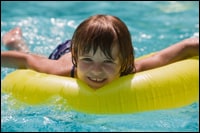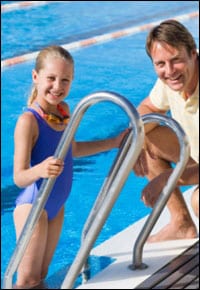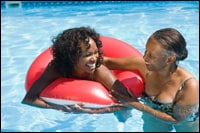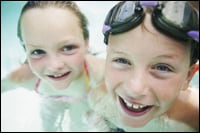Recreational Water Illness (RWI) Prevention Week 2010
Swimming is the third most popular sports activity in the United States1. Although swimming is a physical activity that offers numerous health benefits, recreational water (for example, water in pools) can also spread germs that cause illness.
 May 24–30, 2010, the week before Memorial Day, marks the sixth annual National Recreational Water Illness (RWI) Prevention Week. The goal of this observance is to highlight the simple steps pool operators and swimmers can take to prevent the spread of germs in recreational water. The germs that cause RWIs are spread by swallowing, breathing in the mists or aerosols from, or having contact with contaminated water in swimming pools, water parks, hot tubs, interactive fountains, water play areas, ponds, lakes, springs, rivers, or oceans.
May 24–30, 2010, the week before Memorial Day, marks the sixth annual National Recreational Water Illness (RWI) Prevention Week. The goal of this observance is to highlight the simple steps pool operators and swimmers can take to prevent the spread of germs in recreational water. The germs that cause RWIs are spread by swallowing, breathing in the mists or aerosols from, or having contact with contaminated water in swimming pools, water parks, hot tubs, interactive fountains, water play areas, ponds, lakes, springs, rivers, or oceans.
RWI Prevention Week 2010 Theme: Pool Inspections and the Triple A's of Healthy Swimming
This year's RWI Prevention Week focuses on pool inspections and encourages swimmers to take an active role in preventing the spread of germs that cause RWIs. To ensure a healthy swimming experience for everyone, operators of recreational water venues (for example, community pools) need to properly filter and disinfect the water. Pool inspectors check to make sure pool water and pool facilities meet standards that decrease the risk of RWIs, but they can't be at every pool every day. To help promote a healthy and safe swimming experience each time, the Centers for Disease Control and Prevention (CDC) is encouraging swimmers to take an active role in stopping the spread of germs by following the Triple A's of Healthy Swimming: Awareness, Action, and Advocacy.
Awareness
 Visit CDC's Healthy Swimming website to learn more about staying healthy while swimming.
Visit CDC's Healthy Swimming website to learn more about staying healthy while swimming.- Learn how to protect yourself from RWIs and follow the Steps for Healthy Swimming (listed below)
Action
- Check pool water yourself using test strips purchased at your local hardware or pool supply store. CDC recommends the following water quality levels to kill germs:
- free chlorine levels at 1–3 parts per million (ppm)
- pH 7.2–7.8
*Free test strip kits can be ordered at www.healthypools.org/freeteststrips
- Ask the pool operator these questions:
- Are the free chlorine and pH levels checked at least twice a day and more often when the pool is heavily used?
- What is the latest pool inspection score?
- Has the operator completed specialized training in pool operation?
 Advocacy
Advocacy
- Encourage pool operators to take steps known to kill germs:
- Add ultraviolet or ozone technology to water treatment or
- Hyperchlorinate (add additional chlorine to the pool) regularly
- Educate other swimmers about RWIs and promote healthy swimming (see the "Steps for Healthy Swimming" listed below)
Learn more about the Triple A's of Healthy Swimming.
To learn more about pool inspections and common pool code violations, read CDC's report, "Violations Identified from Routine Swimming Pool Inspections --- Selected States and Counties, United States, 2008."
Keep Germs Out of the Pool
In addition to following the Triple A's of Healthy Swimming, the best way to prevent RWIs is to keep germs out of the pool in the first place. Everyone can help create healthy swimming experiences this summer by following the Steps for Healthy Swimming:
- Don't swim when you have diarrhea.
 Don't swallow pool water.
Don't swallow pool water. - Practice good hygiene. Shower with soap before swimming and wash your hands after using the toilet or changing diapers.
- Take your kids on bathroom breaks or check diapers often.
- Change diapers in a bathroom or a diaper-changing area and not at poolside.
- Wash your child thoroughly (especially the rear end) with soap and water before swimming.
Healthy Swimming Resources
To help get the message out about RWI prevention, CDC's Healthy Swimming Program has developed the following educational materials:
- Healthy swimming brochures available in English and Spanish
- New fact sheets on frequently asked RWI questions
- Two videos, "In the Swim of Things" (3:52 minutes long) and "Healthy Swimming is No Accident" (30 seconds long), reminding swimmers to play it safe and stay out of the water when ill with diarrhea
- Seven podcasts on preventing illness and injury while swimming
 For in-depth information on healthy swimming, go to the Healthy Swimming Web site.
For in-depth information on healthy swimming, go to the Healthy Swimming Web site.
For information on safe swimming at beaches, see The Environmental Protection Agency's (EPA) Beaches Web site.
Think Healthy. Be Healthy. Swim Healthy!
1US Census Bureau. 2009 statistical abstract of the United States. Recreation and leisure activities: participation in selected sports activities 2007 [PDF - 443 KB].
Get email updates
To receive email updates about this page, enter your email address:
Contact Us:
- Centers for Disease Control and Prevention
1600 Clifton Rd
Atlanta, GA 30333 - 800-CDC-INFO
(800-232-4636)
TTY: (888) 232-6348 - Contact CDC–INFO
 ShareCompartir
ShareCompartir
 Having fun while you swim this summer means knowing how to prevent recreational water illnesses. Learn how to stay healthy and germ-free while enjoying the water!
Having fun while you swim this summer means knowing how to prevent recreational water illnesses. Learn how to stay healthy and germ-free while enjoying the water!

